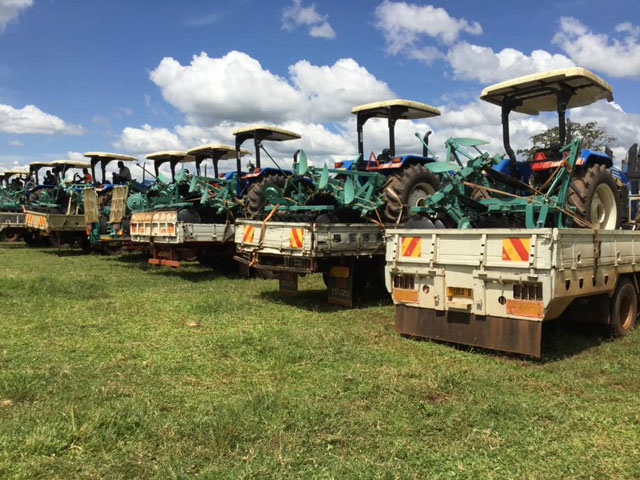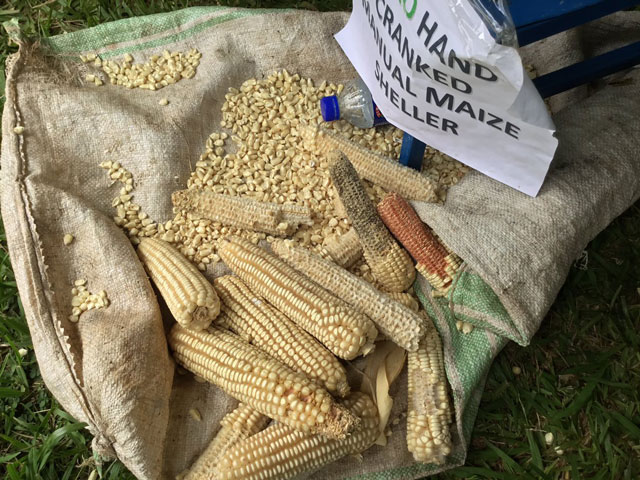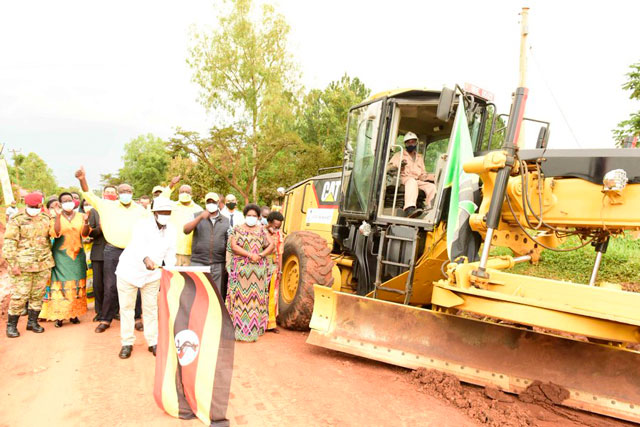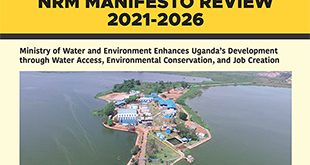
NRM MANIFESTO WEEK | Agriculture sector – Agriculture is one of the major drivers of Uganda’s economic growth with over 64% of the population employed in the sector and with Agriculture-based products accounting for about 43% of exports in FY 2019/20.
The Agriculture sector registered improved growth rates from 2.8% in FY 2015/16 to 4.4% in FY 2019/20. The sector also contributed 23.5% of the GDP.
A number of initiatives were undertaken over the last five years to: increase production and productivity of agricultural commodities and enterprises; increase access to critical farm inputs; improve access to markets and value addition and strengthen the quality of agricultural commodities; and strengthen the agricultural services institutions and also create an enabling environment for the sector to grow.
To ensure farmers’ access to quality inputs, the Ministry initiated pre-delivery seed quality tests of all input dealers. For the seedlings, prior to their delivery by the Suppliers, a joint team of technical officers from NAADS and MAAIF visits the seedling suppliers to ascertain/ verify both the quality and quantity of the seedlings as specified including germination tests. These efforts have seen the Ministry significantly reducing on counterfeit and adulterated farm inputs on the market.

Therefore, the Ministry through NAADS/OWC and other MAAIF Agencies has continued to distribute critical farm inputs. In the last five years, the Ministry has distributed; 19,562,506 kgs of maize seed, 7,086,504 kgs of bean seed, 793,223 bags of cassava cuttings, 410,737,788 tea seedlings, 21,526,743 cocoa seedlings, 17,151 Dairy heifers, 3,412 beef cattle, 632,497 poultry – Birds, 7,405,117 fingerlings for tilapia, 121 sets of milk coolers and matching generators, Tractors, 344 motorized pumps and 400 knapsack spray pumps, among others.
This has led to increase in productivity and production in the country leading to surpluses and increased exports as reflected in the production and export volumes.
In order to efficiently implement the four Acre-Land-Model as part of the National Strategy for commercialization of agriculture, The Ministry has carried out trainings of extension staff and non-state actors on the principles of the four Acre-Land-Model that will be piloted based on the concept of the Village Agent Model
The Ministry has continued to demonstrate the Nucleus Farmer Model in Local Governments. The Nucleus Farmer Model is intended to streamline ways in which Government will empower progressive farmers in specific value chains to be the means of creating linkages between central Government, Local Governments, Extension services, input dealers, NAADS/ OWC activities, Financial and Insurance service providers, Agriculture Research and other private sector value chain actors, at both parish and sub-county level. The model will ease mobilization of farmers into groups and higher-level producer marketing associations and link the farmers to input dealers, traders and financial service
Over the last five years, Government supported scientists in agricultural research and academic institutions to develop novel agricultural technologies and innovations for increased agricultural productivity. Key novel technologies developed include: Over 96 crop varieties (maize, beans, soya beans, ground nuts, bananas, cassava, sorghum, coffee, sweet potatoes and Irish potatoes, among others) that are early maturing, high yielding and resistant to pests and diseases. Two anti-tick vaccines to effectively control blue ear ticks (Boophilus decoloratus), and two bio-acaricide formulations to manage the emerging challenge of tick resistance to available acaricides.
Ugandan scientists also developed three botanical de-wormer drugs for control of internal (Nematode, Cestode and Trematode worms) and external parasites in ruminants as well as a rapid and cheap on-farm diagnostic kit prototype for detection of African swine fever.
Seeds and post harvest handling
The Government facilitated the development of a National Seed Policy that was approved by Cabinet, and the regulations gazetted to provide a regulatory framework for the private sector to invest in the seed sub-sector to ensure that farmers access quality seed.

Through MAAIF, Government increased investment in improved post-harvest handling technologies and value-addition for commercial farming and transformation of small holders and peasant agriculture. Government constructed farmer-based community grain stores across the country to support farmer access to markets through collective marketing in; Kyenjojo, Napak, Adjumani, Kiryandongo, Masindi, Hoima, Kyenjonjo, Mubende, Kakumiro, Kiboga, Nakaseke and Kyegegwa districts.
Government also Established 15 tea factories which are at different levels of completion in the districts of; Kyenjojo (2), Buhweju (4), Kanungu (1), Bushenyi (1), Rukiga (1), Kisoro (1), Ntungamo (1), Kamwenge (1), Mbarara (1) and Luweero (1).
Also, established were five irrigation schemes, which are near completion. These include; Ngenge (880 ha in Kween District) at 90%, Mubuku II (480 ha in Kasese District) at 68%, Doho II (1,178 ha in Butaleja District) at 85%, and Wadelai (1,000 ha Pakwach/Nebbi) at 29%. The schemes will greatly contribute to increased production of rice, aquaculture and horticulture (fruits and vegetables). At the same time, Government completed detailed engineering designs for Sironko/Acomai irrigation Scheme in Bukedea district (1,480ha and 1,600 households are targeted), Atari Irrigation scheme in Kween/Bulambuli District (680ha and 2,667 households targeted) and Namatala Irrigation Scheme in Budaka/ Mbale/ Butaleja District (3,450 ha and 4,923 households targeted).
Trade and Industrialisation
The following achievements were registered during the Manifesto implementation period of 2016 -2021:
- Government implemented the Electronic Single Window (e-SW) Online System that facilitates trade, addresses delays and offers a platform for the business community to deal with the different regulatory agencies in the process of clearing cargo for export, import and transit.
- Government established the trade information portal as provided for within the World Trade Organisation Agreement framework to facilitate trade.
- It also established regional markets and border export zones at Bibia, Malaba, Mpondwe, Katuna, Lamya-Busunga, Ishasha, Mirama Hills, Mutukula, Amudat, Lwakhakha, Suam, Vurra, Oraba, Busia, Lumino, Ntoroko, MadiOpei and Kikagati.
- It completed and operationalised four One Stop Border Points (OSBP) at Mutukula, Busia, Mirama Hills and Elegu.
- Government implemented the harmonised Axle Load Control Measures to enable transporters conform to all EAC partner states weighbridge control standards.
- The Government of Uganda ratified the African Continental Free Trade Area (AfCFTA), which aims to create a single market of 1.2 billion people, with a combined Gross Domestic Product $3.4 trillion.
- Since 2016 Government registered 3,342 new cooperatives bringing the total number of those registered to 19,524, with majority being SACCOs (8,464). Also Government decentralised the Uganda National Bureau of Standards (UNBS) certification and market surveillance services to regional offices in Gulu, Mbale and Mbarara.
Development of the ICT industry
Under the ICT sector, the following achievements were realised between 2016 and 2021:
- Implemented the National Broadband Policy and the attendant sharing infrastructure networks by telecom operators, hence enhanced efficiency and reduced the price of internet data. The price reduced from $5,000 per Mega-Byte in 2007 to $1,200 per Mega-Byte in 2010, and to $70 per Mega-Byte in 2020.
- Laid over 4,000km of ICT fibre optic cables, thereby broadening internet connectivity around the country
- Set up WiFi internet (‘My Ug’), which is accessed by two million people in Kampala and Entebbe from 5:00pm to 6:00am every Monday to Friday, free-of-charge. It is also available 24 hours on weekends.
- Connected 1,180 internet sites for Ministries, Departments, Agencies and Local Governments (MDA&LGs) to the National ICT cable networks, there-by offering connectivity to support e-government services around the country
- Established a National Disaster Recovery site at Jinja and upgraded it to host ICT systems for all government MDAs & LGs. This site also hosts 358 websites and has capacity to take on more.
- Upgraded 22 base stations (Telecommunication Towers) in rural areas from Second Generation (2G) to Third Generation (3G) under the government’s Rural Communication Development Fund, thus providing internet services to over 1,000,000 people.
- Connected major border points to the National ICT infrastructure to support communication and regional trade. These include Uganda-Kenya border at Malaba and Busia, Uganda-South Sudan border at Elegu and Oraba and Uganda-DR Congo border at Mpondwe. Others are the Uganda-Rwanda border at Katuna and Uganda-Tanzania border at Mutukula.
- Revamped UBC with new signal transmission equipment and Digital Terrestrial Television (DTT) equipment which has increased UBC Free-to-Air TV signal coverage from 20% in 2016 to 60% in 2020.
- Installed transmission equipment and UBC radio services have been restored in Kisoro, Rubirizi, Arua, Soroti, Lira, Mbarara and Masaka increasing the radio network coverage from 60% to 70%.
- Installed more radio transmission equipment around border areas including Kapchorwa, Bukwo, Kotido, Kitgum, Pakwach, Rakai, Rubirizi, Rukungiri and Moyo increasing national radio coverage from 70% to 85%.
- Funded 112 young Uganda ICT innovators. A National ICT Innovation Hub with hosting capacity of 800 innovators was constructed at Nakawa in Kampala. Regional ICT Innovation Hubs have been established at Muni, Mbarara, Soroti and Makerere universities.
- Licenced five Business Process Outsourcing (BPO) companies creating over 5,000 jobs. The government’s BPO centre at Statistics House in Kampala employs 240 young people.
- Expanded and equipped the Uganda Institute of ICT to offer quality tailor-made ICT training programmes for the public and private sector and now trains about 22,000 Ugandans in practical ICT-related programmes.
- Set-up and equipped over 1,047 ICT laboratories in secondary schools countrywide, under the Rural Communication Development Fund and trained 8,000 teachers under the ICT teacher-retooling programme.
- Trained Over 10,000 entrepreneurs of Small and Medium Enterprises (SMEs) in ICT use for business operations.
Transport Infrastructure;

In the transport sector, Government:
- Expanded national road network;
- Upgraded 1,584km of road network to tarmac
- Rehabilitated 503km of road network.
- Constructed 110 urban roads measuring approximately 78.4km and four economic infrastructures, which included two taxi parks in Arua and Tororo, a bus terminal in Moroto and lorry park in Fort Portal City.
- Routine maintenance;
- Maintained 3,324km of paved manual and 2,332.2km mechanised national roads.
- Maintained 12,697km of unpaved manual and 14,801.4km mechanised national roads.
- Maintained 22,738.2km of manual and 8,281.8km mechanised district roads.
- Maintained 644km paved and 300km unpaved manual and mechanised KCCA roads.
- Maintained 2,031.6km of paved and unpaved manual and 799.8km of mechanised urban roads.
- Completed the construction of Kampala-Entebbe Expressway with a spur at Munyonyo (51km).
- Completed 62% civil works of Kampala Northern Bypass.
- Rehabilitated 1895.62km and tarmacked 231.22km of District-Urban Community Access Roads (DUCAR) across the country.
- Procured, delivered and distributed 1,151 pieces of road equipment from Japan to District Local Governments (DLGs), UNRA, KCCA and Ministry of Works and Transport (MoWT) Force Account/Zonal Centres.
- Completed 58 bridges across the country.
Energy Infrastructure
- Increased power generation from 924.9 MW in 2016 to 1254.2MW in 2020.
- Completed and commissioned Isimba (183 MW) and Achwa/Agago 2 (42MW) Hydro Power Projects
- Established 11 hydro power generation projects with a total installed capacity of 712.4MW. Once complete, the total installed power generation capacity in the country will be approximately 2,000MW. These plants include;
- Karuma (600MW) at 97.5% plant completion, and transmission at 80% completion
- Nyamasagani I (15MW)
- Nyamasagani 2 (6MW)
- Kikagati (14MW)
- Achwa I (41MW)
- Muyembe 6.9MW
- Nyagak III (5.5MW)
- Muzizi (44MW)
- Bukinda (6.5MW)
- Kakaka (4.6MW)
- Busitema University solar (4MW)
- Commissioned 989km of electricity transmission projects that include;
- 137km, 220kV Kawanda-Masaka transmission line
- 65km, 220kV Mbarara-Mirama transmission line
- 226km, 220kV Nkenda (Kasese)-Hoima transmission line
- 115km, 132kV Lira-Opuyo (Soroti) transmission line
- 42km, 132kV Isimba-Bujagali transmission line
- 157km, 132kV Mbarara-Nkenda transmission line
Therefore, the total length of High Voltage grid coverage is now 2,442km up from 1,453 in 2016.
- Commissioned electricity transmission substations with transformation capacity of 440MVA that include; Queen’s way, Masaka, Mbarara North, Hoima, Iganga, Mukono, Namanve, Luzira, Kapeeka, Kawanda, Karuma, Olyiyo and Mirama.
- Constructed a cumulative Network Line Length of 14,820.45km of Medium Voltage and 10,279.19 Km of Low Voltage lines.
- Connected 558 sub-counties, 10 divisions, 52 town councils to national grid.
Education Infrastructure
- In establishing a government secondary school in every sub-county, Government:
- Constructed 132 Seed Secondary Schools in sub-counties and divisions without a public secondary school.
- Grant-aided 182 community secondary schools to support the policy implementation.
- Established 133 government aided BTVET Institutions of which;
- Six are technical colleges and centres of excellence
- Seventy-three are technical Institutes
- Twenty-nine are community polytechnics
- Twenty-five technical farm schools
- Constructed Uganda Petroleum Institute, Kigumba.
- Completed the construction of 11 staff houses and classroom blocks for education institutions in Adjumani, Moyo, Katakwi, Ngora, Alebtong and Karamoja sub-region.
- Revamped four regional institutions for PWDs;
- Salama P.S
- Mbale S.S
- Wakiso S.S and
- Lalo P.S
- In regard to the policy of establishing at least one public primary school per parish;
- Built additional 929 classrooms in 145 primary schools that previously had less than three permanent classrooms.
- Constructed nine semi-detached teachers’ houses in nine schools in the hard-to-reach district of Bukwo.
- Constructed six semi-detached staff houses at six primary teachers’ colleges; namely Shimoni, Erepi, Kisoro, Ibanda, Rukungiri and Ngora.
Health Infrastructure
- Commissioned the 450 Bed Specialised Women and Neonatal hospital at Mulago.
- Constructed more than 500 housing units in 15 districts for health workers at Mulago National Referral Hospital, Butabika National Mental Referral Hospital, Moroto Regional Referral Hospital, Masaka Regional Referral Hospital, Gulu Regional Referral Hospital, Mbale Regional Referral Hospital and Lira Regional Referral Hospital and at various health centres and hospitals.
- Completed and commissioned Kawempe and Kiruddu Referral Hospitals to decongest Mulago National Referral Hospital.
- Rehabilitated and equipped Lower Mulago Hospital, including additional works to enhance service delivery to a Super-Specialised Hospital.
- Rehabilitated and equipped Kawolo Hospital.
- Expansion of Kayunga and Yumbe General Hospital is ongoing as scheduled.
- Commissioned the Regional Hospital for Paediatric Surgery in Entebbe.
- Construction of the 240-bed International Specialised Hospital at Lubowa is ongoing.
- Rehabilitated and equipped the nine general hospitals of Mityana, Nakaseke, Kiryandongo, Entebbe Grade B, Nebbi, Anaka, Iganga, Moyo and Moroto.
- Renovation and expansion of Lira, Arua and Gulu Regional Referrals Hospitals is ongoing.
- Constructed 10 theatres, 16 maternity wards and water supply for 26 Health Centre IVs (HC IVs) namely: Aboke, Aduku, Atiak, Budaka, Budondo, Bugono, Buvuma, Buyinja, Bwijanga, Kabuyanda, Kasanda, Kibuku, Kiganda, Kikamulo, Kitwe, Kiyunga, Kyantungo, Mwera, Mwizi, Nankoma, Ngoma, Ntenjeru-Kojja, Obongi, Padibe, Pakwach and Rubare.
 The Independent Uganda: You get the Truth we Pay the Price
The Independent Uganda: You get the Truth we Pay the Price



